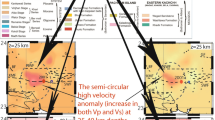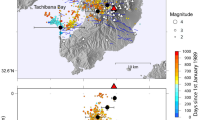Abstract
Since the initial collision at 55 Ma, rocks of the Indian crust below the Himalayas have undergone modification chemically and compositionally due to the ongoing India–Asia convergence. The local earthquake tomography images a shallow (~ 1–2°) north-easterly dipping low-velocity layer (10–20% drop in Vp and Vs, 10–15% increase in Vp/Vs) beneath the region between 10 and 20 km depth, which is inferred as the main Himalayan thrust (MHT). The presence of this low-velocity layer may be attributed to the presence of aqueous/metamorphic fluids or high fluid pressure, which may trigger crustal earthquakes by lowering the frictional coefficient (~ 0.01–0.08) on the MHT. The 1803 Mw8.2 Garhwal, 1991 Mw6.8 Uttarkashi and 1999 Mw6.4 Chamoli earthquakes have also been modelled to be triggered on the MHT, by the presence of aqueous/metamorphic fluids or high pore-fluid pressure. Besides, our modelling predicts three un-ruptured similar low-velocity zones on the MHT for generating future moderate to large fluid-triggered earthquakes in the region. The mapped low-velocity anomalies at 25–35 km depths further support the idea of the presence of a relatively higher temperature due to the hotter mantle below, which induces ductile rheology that prevents the lower crustal seismicity.








Similar content being viewed by others
References
Ader T, Avouac J-P, Liu-Zeng J, Lyon-Caen H, Bollinger L, Galetzka J, Genrich J, Thomas M, Chanard K, Sapkota SN, Rajaure S, Shrestha P, Ding L, Flouzat M (2012) Convergence rate across the Nepal Himalaya and interseismic coupling on the Main Himalayan Thrust: Implications for seismic hazard. J Geophys Res. https://doi.org/10.1029/2011JB009071
Bai L, Klemperer SL, Mori J, Karplus MS, Ding L, Liu D, Li G, Song B, Dhakal S (2019) Lateral variation of the main himalayan thrust controls the rupture length of the 2015 Gorkha earthquake in Nepal. Sci Adv 5(eaav0723):1–7
Benz HM, Chouet BA, Dawson PB, Lahr JC, Page RA, Hole JA (1996) Three dimensional P and S wave velocity structure of Redoubt Volcano, Alaska. J Geophys Res 101:8111–8128
Bilham R (2019) Himalayan earthquakes: a review of historical seismicity and early 21st century slip potential. Geol Soc Lond Spec Publ 483:423–482
Caldwell WB, Klemperer SL, Lawrence JF, Rai SS, Ashis, (2013) Characterizing the main himalayan thrust in the Garhwal Himalaya, India with receiver function CCP stacking. EPSL 367:15–27
Christensen NI, Mooney WD (1995) Seismic velocity structure and composition of the continental crust: a global view. J Geophys Res 100(B6):9761–9788
Copley A, Avouac J-P, Hollingsworth J, Leprince S (2011) The 2001 Mw 7.6 Bhuj earthquake, low fault friction, and the crustal support of plate driving forces in India. J Geophys Res. https://doi.org/10.1029/2010JB008137
Cotton F, Campillo M, Deschamps A, Rastogi BK (1996) Rupture history and seismotectonics of the 1991 Uttarkashi, Himalaya earthquake. Tectonophysics 258:35–51
Drukpa D, Velasco AA, Doser DI (2006) Seismicity in the Kingdom of Bhutan (1937–2003): Evidence for crustal transcurrent deformation. J Geophys Res 111:B06301. https://doi.org/10.1029/2004JB00
Elliott JR, Jolivet R, González PJ, Avouac J-P, Hollingsworth J, Searle MP, Stevens VL (2016) Himalayan megathrust geometry and relation to topography revealed by the Gorkha earthquake. Nature Geosci 9:174–180. https://doi.org/10.1038/ngeo2623
Gupta H, Gahalaut VK (2014) Seismotectonics and large earthquake generation in the Himalayan region. Gondwana Res 25:204–213
Harbindu A, Sharma ML (2012) Stochastic ground-motion simulation of two Himalayan earthquakes: seismic hazard assessment perspective. J Seismology 16:345–369
Hatzfeld D, Molnar P (2010) Comparisons of the Kinematics and deep structures of the Zagros and Himalaya and of the Iranian and Tibetan plateaus and geodynamics implications. Rev Geophys 48:1–48
Herman F et al (2010) Exhumation, crustal deformation, and thermal structure of the Nepal Himalaya derived from the inversion of thermos-chronological and thermos-barametric data and modeling of the topography. J Geophys Res 115:B06407. https://doi.org/10.1029/2008JB006126
Jones AG, Ledo J, Ferguson IJ (2005) Electromagnetic images of the Trans-Hudson orogen: the North American Central Plains anomaly revealed. Can J Earth Sci 42:457–478
Joshi M, Kothyari GC, Ahluvalia A, Pant PD (2010) Neotectonic evidences of rejuvenation in Kaurik-Chango Fault Zone, Northwestern Himalaya. J Geogr Inf Syst 2:169–176
Kayal JR, Ram S, Singh OP, Chakraborty PK, Krunakar G (2003) Aftershock of the 1999 Chamoli earthquake and seismotectonic structure of the Garhwal Himalaya. Bull Seismol Soc Am 93:109–117
Kumar N, Sharma J, Arora BR, Mukopadhyay S (2009) Seismotectonic model of the Kangra-Chamba sector of Northwest Himalaya: Constraints from joint hypocenter determination and focal mechanism. Bull Seismol Soc Am 99:95–109
Langin W, Brown L, Sandvol E (2003) Seismicity in central Tibet from project INDEPTH III seismic recordings. Bull Seism Soc Am 93:2146–2159
Lemonnier C, Marquis G, Perrier F, Avouac J-P, Chitrakar G, Kafle B, Sapkota S, Gautam U, Tiwari D, Bano M (1999) Electrical structure of the Himalaya of central Nepal: high conductivity around the mid-crustal ramp along the MHT. Geophys Res Lett 26:3261–3264
Mahesh P, Rai SS, Sivaram K, Paul A, Gupta S, Sarma R, Gaur VK (2013) One dimensional reference velocity model and precise locations of earthquake hypocenters in the Kumaon-Garhwal Himalaya. Bull Seism Soc Am 103:328–339
Mandal P, Padhy S, Rastogi BK, Kousalya M, Satyanarayana HVS, Satyamurthy C, Vijayraghavan R, Srinivasan A (2001) Aftershock activity and low coda Qc in the epicentral region of the 1999 Chamoli earthquake of Mw 6.4. Pure Appl Geophys 158:1719–1735
Molnar P, Lyon-Caen H (1989) Fault plane solutions of earthquakes and active tectonics of the Tibetan Plateau and its margins. Geophys J Int 99:123–153
Monsalve G, Sheehan A, Schulte-Pelkum V, Rajaure S, Pandey MR, Wu F (2006) Seismicity and one-dimensional velocity structure of the Himalayan collision zone: earthquakes in the crust and upper mantle. J Geophys Res 111:B10301. https://doi.org/10.1029/2005JB004062
Musacchio G, Mooney WD, Luetgert JH (1997) Composition of the crust in the Grenville and Appalachian Provinces of North America inferred from Vp/Vs ratios. J Geophys Res 102:15225–15241
Ni J, Barazangi M (1984) Seismotectonics of the Himalayan collisional zone: geometry of the underthrusting Indian plate beneath the Himalaya. J Geophys Res 89(B2):1147–1163
Pandey MR, Tandukar RP, Avouac JP, Lavé J, Massot JP (1995) Evidence for recent interseismic strain accumulation on a mid-crustal ramp in the central Himalaya of Nepal. Geophys Res Lett 22:751–758. https://doi.org/10.1029/94GL02971
Patel RC, Manmohan KR, Kumar R (2020) Tectonic control on exhumation and seismicity in the Garhwal-Kumaun Himalaya, NW-India. Terra Nova 32:23–33
Pei S, Liu H, Bai L, Liu Y, Sun Q (2016) High-resolution seismic tomography of the 2015 Mw7.8 Gorkha earthquake, Nepal: evidence for the crustal tearing of the Himalayan rift. Geophys Res Lett 43:9045–9052
Rajendran CP, Rajendran K (2005) The status of central seismic gap: a perspective based on the spatial and temporal aspects of the large Himalayan earthquakes. Tectonophysics 395:19–39
Rawat G, Arora BR, Gupta PK (2014) Electrical resistivity cross-section across the Garhwal Himalaya: Proxy to fluid seismicity linkage. Tectonophysics 637:68–79
Schulte-Pelkum V, Monsalve G, Sheehan A, Pandey MR, Sapkota S, Bilham R, Wu F (2005) Imaging the Indian subcontinent beneath the Himalaya. Nature 435:1222–1225
Seeber L, Armbruster J (1981) Great detachment earthquakes along the Himalayan Arc and long-term forecasting, in Earthquake Prediction: An International Review, Maurice Ewing Ser., vol. 4, edited by D. W. Simpson and P. G. Richards, pp. 259–277, AGU, Washington, D. C
Srivastava P, Mitra G (1994) Thrust geometries and deep structure of the outer and lesser Himalaya, Kumaon and Garhwal (India): implications for evolution of the Himalayan fold-and-thrust belt. Tectonics 13:89–109
Turcotte DL, Schubert G (2002) Geodynamics, 2nd edn. Cambridge Univ. Press, Cambridge
Valdiya KS (1980) Geology of the Kumaon Lesser Himalaya, 291 pp., Wadia Inst. of Himalayan Geol., Dehra Dun, India
Vorobieva I, Mandal P, Gorshkov A (2017) Block-and-fault dynamics modelling of the Himalayan frontal arc: implications for seismic cycle, slip deficit, and great earthquakes. J Asian Earth-Sci 148:131–141
Wessel P, Smith WHF, Scharroo R, Luis JF, Wobbe F (2013) Generic mapping tools: improved version released. EOS Trans AGU 94:409–410
Acknowledgements
Authors are grateful to the Director, Council of Scientific and Industrial Research—National Geophysical Research Institute (CSIR-NGRI), Hyderabad, India, for his support and permission to publish this work. Figures were plotted using the Generic Mapping Tool (GMT) software (Wessel et al. 2013). This study was supported by the CSIR-NGRI, Hyderabad, India. The current seismic network in the Kumaon–Garhwal Himalayan region is operated under a Mission-Mode Project (HCP0017) project supported by the CSIR-NGRI. Datasets for this research are included in this paper and its supplementary material.We dedicate this paper to our colleague late Mr. YVVBSN Murthy, who generated the basic phase data of precise P- and S- arrival times for our tomographic study.
Author information
Authors and Affiliations
Corresponding author
Ethics declarations
Conflict of interest
The authors declared that there is no conflict of interest.
Data availability
Datasets for the present study are included in this paper and its supplementary information files. The P- and S- arrival times, earthquake location, and station location data used in the present work can be obtained from the https://www.ngri.org.in/84567952/uk_tomo.zip.
Additional information
Publisher's Note
Springer Nature remains neutral with regard to jurisdictional claims in published maps and institutional affiliations.
Supplementary Information
Below is the link to the electronic supplementary material.
Rights and permissions
About this article
Cite this article
Mandal, P., Srinagesh, D., Vijayaraghavan, R. et al. Seismic velocity imaging of the Kumaon–Garhwal Himalaya, India. Nat Hazards 111, 2241–2260 (2022). https://doi.org/10.1007/s11069-021-05135-4
Received:
Accepted:
Published:
Issue Date:
DOI: https://doi.org/10.1007/s11069-021-05135-4




